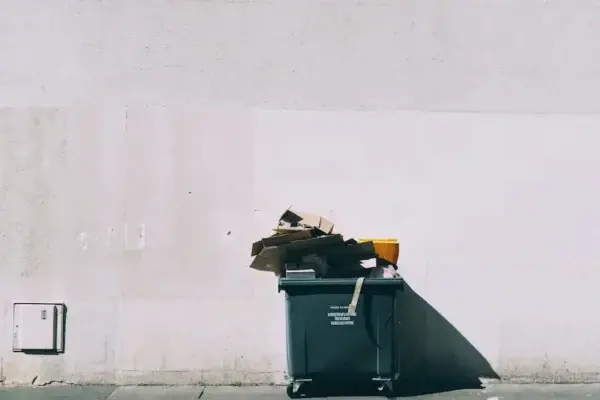What does the future of waste management look like? Many argue that an IoT revolution is coming, one that will reshape the majority of business models and operations. Technological innovations and megatrends in the industry will unquestionably bring about new opportunities to expand and boost efficiency and profitability.
Global waste management is now one of the most significant industries, with its market size expected to rise to $485 billion by 2025. Being struck by a wave of technological advancement, the industry has like many others began shifting its focus toward the pursuit of sustainable development.
Solutions made possible by digitalization have sparked megatrends throughout the waste management industry. They allow us to create more sustainable visions of the future and many have already begun to have an effect on the community.
WasteHero takes a look at 5 technological innovations that are fundamental to the revolution of waste management.
#1 Smart bin sensors & Waste Monitoring Platforms
The introduction of smart bin sensors and advanced software is optimizing route scheduling and the overall logistics of waste collections. By accurately measuring bin fill levels, collections can be planned based on when they are necessary as opposed to fixed collection schedules.
By optimizing waste collection routes and reducing the number of vehicles on the roads, cities and businesses can reduce fuel costs and CO2 emissions. Waste monitoring platforms can also be used to enhance recycling initiatives as volumes can be measured and tracked according to the specific KPIs and goals.
With the capability of this software improving all the time, more precise routes can be planned and a more dynamic, needs-based system achieved. It is changing the way that waste collectors manage their fleets, creating value and efficiency for organizations.
Cities can adopt an end-to-end solution and completely restructure their existing systems to be more environmentally friendly and economically advantageous. Overall, this technology is changing the way that waste management is executed globally, paving the way for more sustainable and financially efficient operations.
#2 Predictive Maintenance
The development of IoT technologies has also led to a different way of monitoring and prolonging the lifespan of assets within waste management. Optimization platforms can be used to monitor the health of assets within fleet management such as vehicles, containers and other machinery.
This allows waste managers to be more proactive in regard to the maintenance of their resources, even predicting the timing of shutdowns and need for repairs.
The use of these innovations has changed the game for maintenance, enabling more efficient preservation of equipment and more timely repairs.
#3 Robotics & The Sorting Process
Traditionally, the sorting of waste materials is done by human employees, however, the emergence of AI sensors and robotics has been groundbreaking for this process. Using robotics to sort through waste has meant that more fractions can be separated faster, with less contamination.
Advanced screening technology can automate this process, leading to more cost-effective operations. Whether or not this role can become fully automated depends solely on the rate that AI progresses.
Robotic pickers are predicted to be able to sort through landfill and identify recyclable items, making the organization of waste more accurate than ever before. Optimizing the recycling and reuse of waste items demonstrates how robotics can also be a key contributor to striving toward a more circular economy.
#4 Autonomous Vehicles & Workforce
As well as robotic screening machinery, it’s predicted that vehicles and other areas of the workforce will be automated. While this may seem too futuristic to imagine being implemented right now, it is argued to be a key part of the new age of waste management.
With the fifth-highest accident rate of all jobs in the US, working in the waste industry can be extremely dangerous. For this reason, many waste workers leave the occupation due to safety concerns. Autonomous vehicles could be the answer to improving safety standards and the perpetual issue of labour turnover within the waste sector.
#5 Waste-to-Energy Plants
One of the most prevalent and major questions discussed by thought leaders within the industry is how can we better convert waste into energy. Transforming waste into actual power, as opposed to letting it sit in landfills, could provide answers for climate change.
For every ton of trash disposed of in landfill, about 6.2 tonnes of CO2 equivalent goes into the atmosphere in the form of methane. Methane is 86 times more potent than CO2 as a climate change gas over a 20 year period.
While incineration tends to be the most used, waste-to-energy plants are revamping gasification methods to extract energy such as carbon and hydrogen within solid waste e.g. plastics, paper etc. It focuses on producing good quality syngas (synthetic gas) that can become a higher-value energy end-product.
Along with high-tech recycling plants turning waste into speciality materials, electricity or fuel, other innovative companies are transforming waste into sellable products such as clothing and shoes. All of these initiatives help contribute to the vision of a zero-waste society.
The Pressure to Pursue Sustainability
It’s clear that the waste industry needs to implement measures toward a more sustainable future. However, policy instruments and other governance of waste management can be difficult for some municipalities and larger enterprises to adhere to. Can technological innovations be the vehicle through which real change can be made within the industry?
Those businesses and cities with up-to-date insights into developing technologies can successfully comply with these policies, as well as gain a significant competitive advantage within the industry.
WasteHero’s optical smart sensor technology allows for waste fill levels to be accurately measured. Combined with our comprehensive platform, cities and businesses can plan dynamic, needs-based routing to eliminate unnecessary pick-ups and avoid excess CO2 emissions.




